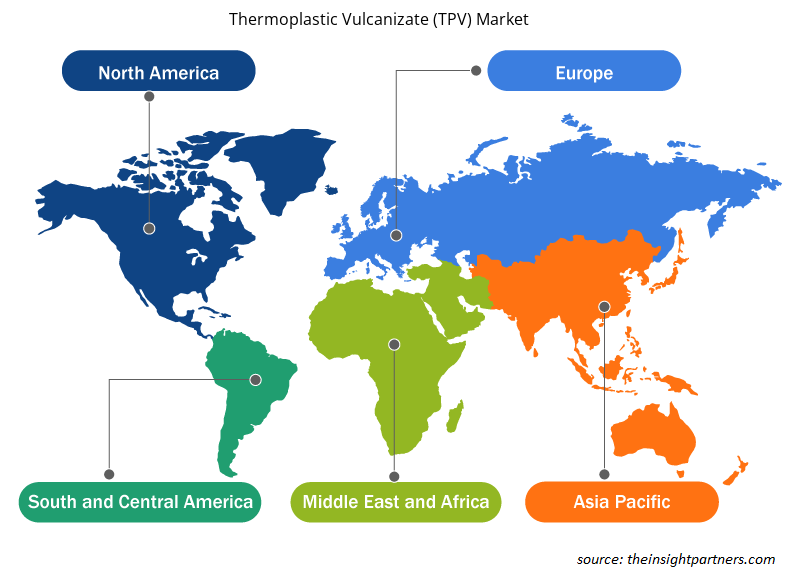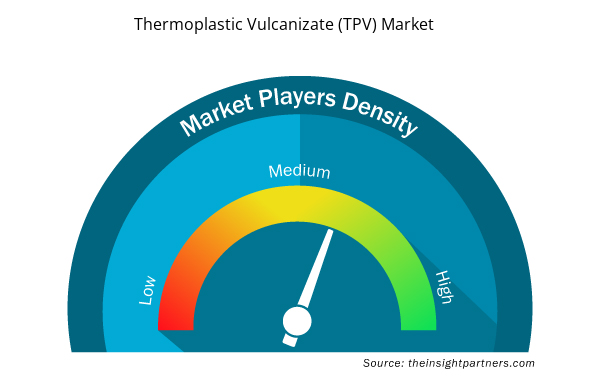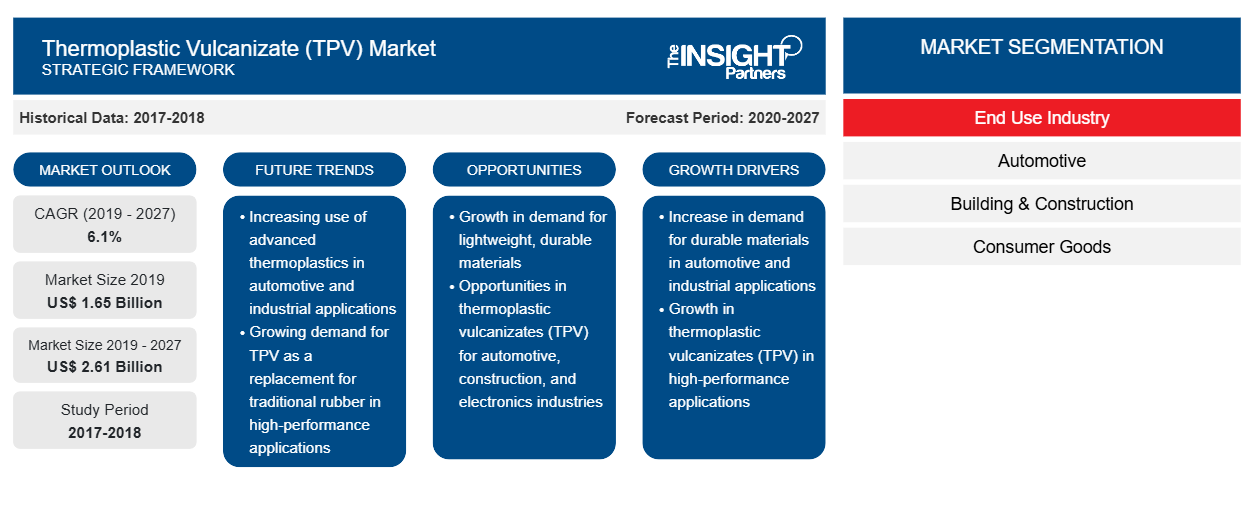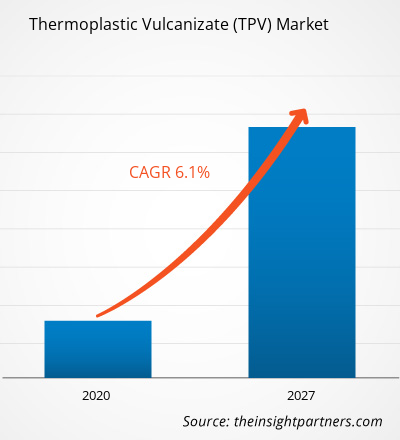بلغت قيمة سوق الفلكنة الحرارية البلاستيكية (TPV) 1،646.78 مليون دولار أمريكي في عام 2019 ومن المتوقع أن تصل إلى 2،612.50 مليون دولار أمريكي بحلول عام 2027؛ ومن المتوقع أن ينمو بمعدل نمو سنوي مركب قدره 6.1٪ خلال الفترة المتوقعة.
تُستخدم المواد البركنة الحرارية البلاستيكية في مجموعة متنوعة من المنتجات مثل الغسالات والمجففات وغسالات الصحون والأجهزة الصغيرة والمقابض والأختام والثلاجات، للأجزاء الصلبة والأختام. ومن المتوقع أن يزداد الطلب على المواد البركنة الحرارية البلاستيكية في قطاع السلع الاستهلاكية نظرًا لفوائدها المتمثلة في كونها مواد خفيفة الوزن ومتعددة الاستخدامات وناعمة في مجالات تطبيق مختلفة، بما في ذلك الملابس والأجهزة المنزلية ومنتجات العناية الشخصية وأدوات المطبخ والأدوات الكهربائية. وعلاوة على ذلك، من المتوقع أيضًا أن يكون لنمو صناعة السلع الاستهلاكية في دول مجموعة البريكس تأثير إيجابي على سوق المواد البركنة الحرارية البلاستيكية. توفر المواد البركنة الحرارية البلاستيكية كفاءة ممتازة وتكاليف نظام منخفضة واستدامة محتملة. ونظرًا لهذه الفوائد، تُستخدم المواد البركنة الحرارية البلاستيكية في صناعة السلع الاستهلاكية. على سبيل المثال، تنتج شركة إكسون موبيل للكيماويات المواد البركنة الحرارية البلاستيكية مع الإيلاستومرات عالية الأداء التي توفر تنوعًا في الإنتاج وسهولة المعالجة والمتانة. من خلال توفير أداء متفوق ومتسق عبر التطبيقات الصناعية والاستهلاكية الصعبة، توفر TPV إمكانية خفض تكاليف الأجهزة وتقليل الوزن وإمكانية إعادة التدوير مقارنة بمواد مثل EPDM (العمود الفقري للإيثيلين والبروبيلين والديين والبولي ميثيلين) أو المطاط الصلب بالحرارة الآخر.
من المتوقع أن تستحوذ أمريكا الشمالية على أكبر حصة من سوق البوليمر الحراري العالمي خلال الفترة المتوقعة. تتمتع العديد من الشركات المحلية والدولية بموطئ قدم قوي في منطقة أمريكا الشمالية. يُعزى نمو سوق البوليمر الحراري في هذه المنطقة في المقام الأول إلى الطلب المتزايد على المواد خفيفة الوزن لإنتاج العديد من مكونات السيارات. علاوة على ذلك، من المتوقع أن تؤدي اللوائح الحكومية المواتية المتعلقة باستهلاك البوليمر الحراري في تطبيقات السيارات كبديل للسبائك والمعادن، جنبًا إلى جنب مع زيادة إنتاج سيارات الركاب في الولايات المتحدة والمكسيك، إلى زيادة نمو السوق الإقليمية خلال الفترة المتوقعة. علاوة على ذلك، أدت التطورات التقنية والطلب المتزايد على المركبات الكهربائية إلى زيادة الحاجة إلى السلع خفيفة الوزن والمتينة والقابلة لإعادة التدوير، مما دفع بدوره نمو السوق.
الولايات المتحدة والهند والبرازيل وروسيا وفرنسا والمملكة المتحدة وتركيا وإيطاليا وإسبانيا من بين الدول الأكثر تضررًا من حيث الحالات المؤكدة والوفيات المبلغ عنها بسبب COVID-19، اعتبارًا من ديسمبر 2020. وفقًا لبيانات منظمة الصحة العالمية اعتبارًا من ديسمبر 2020، تم الإبلاغ عن حوالي 80،453،105 حالة مؤكدة و1،775،776 حالة وفاة في العالم. أثر جائحة COVID-19 على الاقتصادات بسبب عمليات الإغلاق وحظر السفر وإغلاق الأعمال. تعد صناعة المواد الكيميائية والمواد العالمية واحدة من الشركات الرئيسية التي تعاني من انقطاع سلسلة التوريد وانقطاعات التصنيع بسبب هذه القيود. تعد الصين المركز العالمي للتصنيع وأكبر مورد للمواد الخام لمختلف الصناعات. يؤثر إغلاق العديد من المصانع والمصانع في المناطق الرائدة، مثل منطقة آسيا والمحيط الهادئ وأوروبا، على سلاسل التوريد العالمية ويؤثر سلبًا على التصنيع وجداول التسليم ومبيعات المنتجات. أثرت هذه العوامل سلبًا على نمو سوق البوليمر الحراري العالمي (TPV).vulcanizate (TPV) market growth.
قم بتخصيص هذا التقرير ليناسب متطلباتك
ستحصل على تخصيص لأي تقرير - مجانًا - بما في ذلك أجزاء من هذا التقرير، أو تحليل على مستوى الدولة، وحزمة بيانات Excel، بالإضافة إلى الاستفادة من العروض والخصومات الرائعة للشركات الناشئة والجامعات
- احصل على أهم اتجاهات السوق الرئيسية لهذا التقرير.ستتضمن هذه العينة المجانية تحليلاً للبيانات، بدءًا من اتجاهات السوق وحتى التقديرات والتوقعات.
رؤى السوق
استخدام مادة البوليمر الحراري القائمة على أساس حيوي
من أجل تقليل الاعتماد على الموارد غير المتجددة، مثل البترول، وتحقيق التنمية المستدامة لصناعة المواد البوليمرية، يفضل عدد كبير من الناس المواد البوليمرية القائمة على المواد الحيوية. تُصنع المواد البوليمرية القائمة على المواد الحيوية من البولي لاكتيد (PLA) ومطاط أسيتات الإيثيلين كو فينيل (EVA) الذي تم تصنيعه باستخدام بيروكسيد الديكوميل (DCP) كعامل معالجة؛ وهي المرة الأولى التي يتم فيها إثبات استخدام PLA في المواد المرنة. نظرًا لأن المواد البوليمرية القائمة على المواد الحيوية تحتوي على انبعاثات كربونية منخفضة وقابلة للتحلل البيولوجي بطبيعتها، فإن تصنيعها أمر مشجع في معظم البلدان. تعتبر حاليًا بدائل مستدامة للبوليمرات التقليدية القائمة على البترول لأنها مشتقة من موارد متجددة مثل البوليمرات القائمة على النشا والبولي لاكتيد (PLAs) والبولي هيدروكسي ألكانوات (PHAs) والبوليمرات القائمة على السليلوز والبوليمرات القائمة على الصويا. وبما أن TPEs القائمة على المواد الحيوية لا توفر حلاً نظيفًا فحسب، بل توفر أيضًا لمنتجي TPEs القائمة على المواد الحيوية القدرة التنافسية من حيث التكلفة مقارنة بنظرائهم الاصطناعيين، فمن المتوقع أن تخلق فرص نمو كبيرة في السوق.
رؤى حول الاستخدام النهائي للصناعة
بناءً على صناعة الاستخدام النهائي، يتم تقسيم سوق مواد البركنة بالحرارة البلاستيكية (TPV) إلى السيارات والبناء والتشييد والسلع الاستهلاكية والرعاية الصحية وغيرها. في عام 2019، هيمن قطاع السيارات على السوق. شهدت المواد خفيفة الوزن للسيارات نموًا قويًا على مدار السنوات القليلة الماضية بسبب الطلب المتزايد على المركبات الفاخرة ومنخفضة الانبعاثات والآمنة وعالية الأداء. ونتيجة لذلك، أطلق الموردون والمصنعون عددًا من الحلول التي لا تساعد الشركات المصنعة للمعدات الأصلية على الامتثال للوائح الصارمة فحسب، بل تلبي أيضًا النطاق المتوسع من متطلبات العملاء الشخصية. تعد TPVs أيضًا بديلاً معقولاً للمطاط الصناعي الباهظ الثمن. إنها توفر متانة مرنة ممتازة، بما في ذلك قوة الشد العالية نسبيًا والاستطالة عند وقت الكسر، والتعافي المرن العالي بالإضافة إلى الاستقرار البعدي الجيد في الهواء الساخن، والمقاومة الممتازة للشيخوخة بالأشعة فوق البنفسجية والأوزون والعوامل الجوية. تتضمن التطبيقات الرئيسية لـ TVP في صناعة السيارات أغطية الخراطيم وأغطية قنوات دخول الهواء والحشيات والأختام والأغطية الملتوية ومثبطات الاهتزاز وأغطية الدعامات وأجزاء الإشعال والبطانات وأختام النوافذ. تشمل مكونات TPV المرنة للسيارات تحت غطاء المحرك أنابيب سحب الهواء ومنفاخ الهواء وفتحات العجلات ومنفاخ نظام التوجيه وأجزاء تخفيف الصوت. علاوة على ذلك، تعتبر تكلفة TPVs أقل بنسبة 10-30% من EPDM، جنبًا إلى جنب مع الوزن المنخفض والتنوع المحسن في التصميم وقابلية إعادة التدوير.
تعد شركة Mitsui Chemicals Inc. وCelanese Corporation وMitsubishi Chemical Corporation وKumho Polychem وTrinseo وTeknor Apex وExxonMobil وZeon Chemicals LP وAlphagary وRavago من بين اللاعبين الرئيسيين الحاضرين في سوق البوليمرات الحرارية العالمية. تعمل هذه الشركات على تنفيذ استراتيجيات تطوير المنتجات الجديدة والاندماج والاستحواذ لتوسيع قاعدة عملائها والحصول على حصة سوقية كبيرة في السوق العالمية، مما يسمح لها بدوره بالحفاظ على اسم علامتها التجارية.
تقرير يسلط الضوء على
- الاتجاهات الصناعية التقدمية في سوق الفلكنة الحرارية العالمية (TPV) التي تساعد اللاعبين على تطوير استراتيجيات فعالة طويلة الأجل
- استراتيجيات نمو الأعمال التي تتبناها الأسواق المتقدمة والنامية
- التحليل الكمي لسوق الفلكنة الحرارية العالمية (TPV) من عام 2017 إلى عام 2027
- تقدير الطلب العالمي على البوليمرات الحرارية المبركنة (TPV) عبر مختلف الصناعات
- تحليل PEST لتوضيح فعالية المشترين والموردين العاملين في الصناعة
- التطورات الأخيرة لفهم سيناريو السوق التنافسية والطلب العالمي على البوليمرات الحرارية المبركنة (TPV)
- اتجاهات السوق وتوقعاتها والعوامل التي تدفع وتحد من نمو سوق الفلكنة الحرارية العالمية (TPV)
- فهم الاستراتيجيات التي تدعم المصلحة التجارية فيما يتعلق بنمو السوق
- حجم سوق البوليمر الحراري البلاستيكي العالمي (TPV) في مختلف مناطق السوق
- نظرة عامة مفصلة وتقسيم السوق، بالإضافة إلى ديناميكيات صناعته
- حجم سوق البوليمر الحراري البلاستيكي العالمي (TPV) في مناطق مختلفة مع فرص نمو واعدة في المناطق المعنية
رؤى إقليمية حول سوق البوليمرات الحرارية المطاطية (TPV)
لقد قام المحللون في Insight Partners بشرح الاتجاهات والعوامل الإقليمية المؤثرة على سوق البوليمر الحراري المبركن (TPV) طوال فترة التوقعات بشكل شامل. يناقش هذا القسم أيضًا قطاعات سوق البوليمر الحراري المبركن (TPV) والجغرافيا في جميع أنحاء أمريكا الشمالية وأوروبا ومنطقة آسيا والمحيط الهادئ والشرق الأوسط وأفريقيا وأمريكا الجنوبية والوسطى.

- احصل على البيانات الإقليمية المحددة لسوق البوليمرات الحرارية المبركنة (TPV)
نطاق تقرير سوق البوليمرات الحرارية البلاستيكية (TPV)
| سمة التقرير | تفاصيل |
|---|---|
| حجم السوق في عام 2019 | 1.65 مليار دولار أمريكي |
| حجم السوق بحلول عام 2027 | 2.61 مليار دولار أمريكي |
| معدل النمو السنوي المركب العالمي (2019 - 2027) | 6.1% |
| البيانات التاريخية | 2017-2018 |
| فترة التنبؤ | 2020-2027 |
| القطاعات المغطاة | حسب صناعة الاستخدام النهائي
|
| المناطق والدول المغطاة | أمريكا الشمالية
|
| قادة السوق وملفات تعريف الشركات الرئيسية |
|
كثافة اللاعبين في سوق البوليمرات الحرارية البلاستيكية (TPV): فهم تأثيرها على ديناميكيات الأعمال
يشهد سوق البوليمرات الحرارية المطاطية (TPV) نموًا سريعًا، مدفوعًا بالطلب المتزايد من المستخدم النهائي بسبب عوامل مثل تفضيلات المستهلك المتطورة والتقدم التكنولوجي والوعي المتزايد بفوائد المنتج. ومع ارتفاع الطلب، تعمل الشركات على توسيع عروضها والابتكار لتلبية احتياجات المستهلكين والاستفادة من الاتجاهات الناشئة، مما يؤدي إلى زيادة نمو السوق.
تشير كثافة اللاعبين في السوق إلى توزيع الشركات أو المؤسسات العاملة في سوق أو صناعة معينة. وهي تشير إلى عدد المنافسين (اللاعبين في السوق) الموجودين في مساحة سوق معينة نسبة إلى حجمها أو قيمتها السوقية الإجمالية.
الشركات الرئيسية العاملة في سوق الفلكنة بالحرارة البلاستيكية (TPV) هي:
- شركة ميتسوي للكيماويات
- شركة سيلانيز
- شركة ميتسوبيشي للكيماويات
- كومهو بوليكيم
- ترينسيو
إخلاء المسؤولية : الشركات المذكورة أعلاه ليست مرتبة بأي ترتيب معين.

- احصل على نظرة عامة على أهم اللاعبين الرئيسيين في سوق البوليمرات الحرارية البلاستيكية (TPV)
سوق البوليمرات الحرارية البلاستيكية (TPV)، حسب صناعة الاستخدام النهائي
- السيارات
- البناء والتشييد
- السلع الاستهلاكية
- الرعاية الصحية
- آحرون
نبذة عن الشركة
- شركة ميتسوي للكيماويات
- شركة سيلانيز
- شركة ميتسوبيشي للكيماويات
- كومهو بوليكيم
- ترينسيو
- تكنور ايبكس
- إكسون موبيل
- زيون للكيماويات
- الأبجدية
- رافاجو
- التحليل التاريخي (سنتان)، السنة الأساسية، التوقعات (7 سنوات) مع معدل النمو السنوي المركب
- تحليل PEST و SWOT
- حجم السوق والقيمة / الحجم - عالميًا وإقليميًا وقطريًا
- الصناعة والمنافسة
- مجموعة بيانات Excel


- Mobile Phone Insurance Market
- Maritime Analytics Market
- Artificial Intelligence in Defense Market
- Vision Guided Robotics Software Market
- Authentication and Brand Protection Market
- Grant Management Software Market
- Quantitative Structure-Activity Relationship (QSAR) Market
- Constipation Treatment Market
- Sleep Apnea Diagnostics Market
- Hydrocephalus Shunts Market

Report Coverage
Revenue forecast, Company Analysis, Industry landscape, Growth factors, and Trends

Segment Covered
This text is related
to segments covered.

Regional Scope
North America, Europe, Asia Pacific, Middle East & Africa, South & Central America

Country Scope
This text is related
to country scope.
الأسئلة الشائعة
The growth of the automotive segment is primarily attributed to the fact that the growing demand for luxurious, low-emission, safe, and high-performance vehicles. The key applications of TVP in the automotive industry include hose covers, air inlet duct covers, gaskets, seals, convoluted boots, vibration-dampers, strut covers, ignition parts, bushings, and window seals. Flexible TPV automotive under-the-hood components include air intake tubes and bellows, well flares of the wheel, bellows of the steering system, and sound abatement parts. All these factors are responsible for the berries segment to grow at the highest rate.
The major players operating in the global thermoplastic vulcanizate (TPV) market are Mitsui Chemicals, Inc., Celanese Corporation, Mitsubishi Chemical Corporation, Kumho Polychem, Trinseo, Teknor Apex, ExxonMobil, Zeon Chemicals L.P., Alphagary and Ravago among many others.
In 2019, the thermoplastic vulcanizate (TPV) market was predominant in North America at the global level. Surge in demand of thermoplastic vulcanizate (TPV) in various end use industries such as automotive, building & construction, consumer goods, healthcare, and others has had a noteworthy influence on the thermoplastic vulcanizate (TPV) market in North America. The market for thermoplastic vulcanizate (TPV) in North America is witnessing growth owing to the presence of well-established players such as Mitsubishi Chemical Corporation, Teknor Apex, Zeon Chemicals L.P., and others in this region. With the rise in demand for the lightweight and high-performance materials in the automotive industry in the region is expected to continue to grow over the projected period. The popularity of the thermoplastic vulcanizate (TPV) has increased within the region, particularly in US, Canada, and Mexico. Its use in chemical and materials industry has had a noteworthy influence on the thermoplastic vulcanizate (TPV) market in North America. Favorable government regulations pertaining to TPV consumption in automotive applications as an alternative to alloys and metals, along with increasing passenger car production in the U.S. and Mexico, are expected to further fuel regional market growth over the forecast period. Further, technical advances and growing demand for electric vehicles have increased the need for lightweight, robust and recyclable goods. The steady rise in electric vehicles on the roads is expected to fuel the growth of the market in North America. The market for thermoplastic vulcanizate (TPV) is picking up pace in this region, owing to the development of new manufacturing industries together with the government support to increase the industrial production in chemical and materials sector.
The List of Companies - Thermoplastic Vulcanizate Market
- Mitsui Chemicals, Inc.
- Celanese Corporation
- Mitsubishi Chemical Corporation
- Kumho Polychem
- Trinseo
- Teknor Apex
- ExxonMobil
- Zeon Chemicals L.P.
- Alphagary
- Ravago Manufacturing
The Insight Partners performs research in 4 major stages: Data Collection & Secondary Research, Primary Research, Data Analysis and Data Triangulation & Final Review.
- Data Collection and Secondary Research:
As a market research and consulting firm operating from a decade, we have published and advised several client across the globe. First step for any study will start with an assessment of currently available data and insights from existing reports. Further, historical and current market information is collected from Investor Presentations, Annual Reports, SEC Filings, etc., and other information related to company’s performance and market positioning are gathered from Paid Databases (Factiva, Hoovers, and Reuters) and various other publications available in public domain.
Several associations trade associates, technical forums, institutes, societies and organization are accessed to gain technical as well as market related insights through their publications such as research papers, blogs and press releases related to the studies are referred to get cues about the market. Further, white papers, journals, magazines, and other news articles published in last 3 years are scrutinized and analyzed to understand the current market trends.
- Primary Research:
The primarily interview analysis comprise of data obtained from industry participants interview and answers to survey questions gathered by in-house primary team.
For primary research, interviews are conducted with industry experts/CEOs/Marketing Managers/VPs/Subject Matter Experts from both demand and supply side to get a 360-degree view of the market. The primary team conducts several interviews based on the complexity of the markets to understand the various market trends and dynamics which makes research more credible and precise.
A typical research interview fulfils the following functions:
- Provides first-hand information on the market size, market trends, growth trends, competitive landscape, and outlook
- Validates and strengthens in-house secondary research findings
- Develops the analysis team’s expertise and market understanding
Primary research involves email interactions and telephone interviews for each market, category, segment, and sub-segment across geographies. The participants who typically take part in such a process include, but are not limited to:
- Industry participants: VPs, business development managers, market intelligence managers and national sales managers
- Outside experts: Valuation experts, research analysts and key opinion leaders specializing in the electronics and semiconductor industry.
Below is the breakup of our primary respondents by company, designation, and region:

Once we receive the confirmation from primary research sources or primary respondents, we finalize the base year market estimation and forecast the data as per the macroeconomic and microeconomic factors assessed during data collection.
- Data Analysis:
Once data is validated through both secondary as well as primary respondents, we finalize the market estimations by hypothesis formulation and factor analysis at regional and country level.
- Macro-Economic Factor Analysis:
We analyse macroeconomic indicators such the gross domestic product (GDP), increase in the demand for goods and services across industries, technological advancement, regional economic growth, governmental policies, the influence of COVID-19, PEST analysis, and other aspects. This analysis aids in setting benchmarks for various nations/regions and approximating market splits. Additionally, the general trend of the aforementioned components aid in determining the market's development possibilities.
- Country Level Data:
Various factors that are especially aligned to the country are taken into account to determine the market size for a certain area and country, including the presence of vendors, such as headquarters and offices, the country's GDP, demand patterns, and industry growth. To comprehend the market dynamics for the nation, a number of growth variables, inhibitors, application areas, and current market trends are researched. The aforementioned elements aid in determining the country's overall market's growth potential.
- Company Profile:
The “Table of Contents” is formulated by listing and analyzing more than 25 - 30 companies operating in the market ecosystem across geographies. However, we profile only 10 companies as a standard practice in our syndicate reports. These 10 companies comprise leading, emerging, and regional players. Nonetheless, our analysis is not restricted to the 10 listed companies, we also analyze other companies present in the market to develop a holistic view and understand the prevailing trends. The “Company Profiles” section in the report covers key facts, business description, products & services, financial information, SWOT analysis, and key developments. The financial information presented is extracted from the annual reports and official documents of the publicly listed companies. Upon collecting the information for the sections of respective companies, we verify them via various primary sources and then compile the data in respective company profiles. The company level information helps us in deriving the base number as well as in forecasting the market size.
- Developing Base Number:
Aggregation of sales statistics (2020-2022) and macro-economic factor, and other secondary and primary research insights are utilized to arrive at base number and related market shares for 2022. The data gaps are identified in this step and relevant market data is analyzed, collected from paid primary interviews or databases. On finalizing the base year market size, forecasts are developed on the basis of macro-economic, industry and market growth factors and company level analysis.
- Data Triangulation and Final Review:
The market findings and base year market size calculations are validated from supply as well as demand side. Demand side validations are based on macro-economic factor analysis and benchmarks for respective regions and countries. In case of supply side validations, revenues of major companies are estimated (in case not available) based on industry benchmark, approximate number of employees, product portfolio, and primary interviews revenues are gathered. Further revenue from target product/service segment is assessed to avoid overshooting of market statistics. In case of heavy deviations between supply and demand side values, all thes steps are repeated to achieve synchronization.
We follow an iterative model, wherein we share our research findings with Subject Matter Experts (SME’s) and Key Opinion Leaders (KOLs) until consensus view of the market is not formulated – this model negates any drastic deviation in the opinions of experts. Only validated and universally acceptable research findings are quoted in our reports.
We have important check points that we use to validate our research findings – which we call – data triangulation, where we validate the information, we generate from secondary sources with primary interviews and then we re-validate with our internal data bases and Subject matter experts. This comprehensive model enables us to deliver high quality, reliable data in shortest possible time.


 احصل على عينة مجانية لهذا التقرير
احصل على عينة مجانية لهذا التقرير